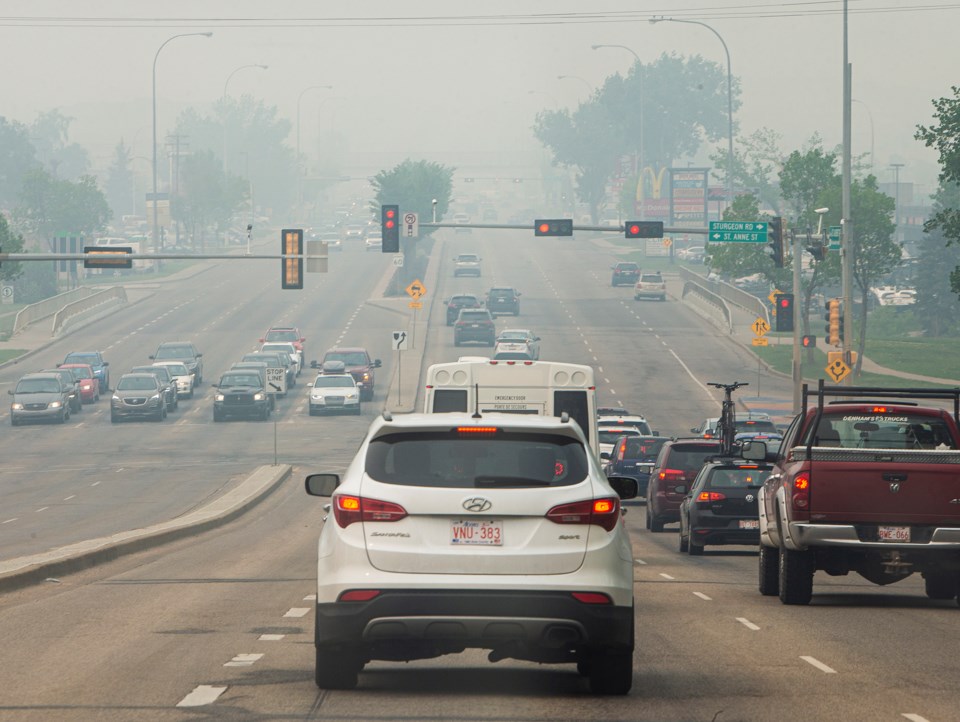Environment Canada has placed a special air quality alert for much of the capital region including St. Albert as smoke from northern Alberta wildfires billows across the area.
“Smoke from wildfires in northern Alberta is causing poor air quality and reducing visibility in some areas,” a news release issued Thursday morning said. “In central parts of the province smoke is expected to move back north by Friday morning as the flow shifts to southeasterly.”
As of Wednesday, the out-of-control wildfire has grown to more than 150,000 hectares, causing many residents in threatened northern Alberta communities to flee their homes.
Mandatory evacuation orders have been issued for La Crete Ferry Campground, Steen River, Hawk Hills, Keg River, Carcajou and for residents living between Township Road 922 and north to Northern Lights County. The fire is also encroaching on the community of Slave Lake as crews continue to battle back the blaze at High Level.
St. Albert’s air quality on Thursday reached a high of six or moderate risk before dropping to four by the afternoon. The haze was so thick that the sky appeared orange in some cases.
On Friday, the air quality forecast had a four or moderate risk and is expected to be at this level on Saturday.
The air quality scare goes from one, considered low risk, to 10 and above being high or very high risk.
With the air quality so poor, Alberta Health Services (AHS) has advised reducing or rescheduling strenuous activities outdoors especially if experiencing symptoms including difficulty breathing.
People with lung diseases such as asthma and Chronic Obstructive Pulmonary Disease can be particularly sensitive to air pollution and can generally experience more serious health effects at lower levels, Environment Canada warns.
Dr. Kathryn Koliaska, a medical officer with AHS, said the impacts of the smoke haze really depend on the individual and which way the wind is blowing.
“People who are healthy and aren’t typically bothered as much by breathing smoke particles may be fine at a moderate Air Quality Health Index (AQHI) level of five or six but then have some runny eyes or a burning throat if the Air Quality Health Index goes a bit higher to seven or eight,” she said. “Whereas little kids who have higher breathing patterns and smaller lungs and smaller bodies or may be asthmatic might have symptoms at a lower number than somebody who has a different health status. So it really does depend.”
The shift in air quality also coincides with the annual International Children's Festival of the Arts, which started Tuesday and wraps on Sunday. Koliaska recommended parents keep a sharp eye on the forecast option for whatever air quality monitor they are following and plan their day accordingly.
“You might say ‘oh, well the morning (forecast) is better than the afternoon forecast' or vice versa, whatever that looks like,” she said. “You can plan your day accordingly around that. I remember that there were indoor activities as well as outdoor activities. So if the smoke is really bad, indoor air will have some filtration. So taking a break in a cleaner air place is something else people can consider.”
To better track the city’s air quality, St. Albert opened its first monitoring station in June 2016 at Salisbury Park next to the Sturgeon Reservoir. The station measures a number of components including particulate matter, nitrogen dioxide and ground-level ozone. The station provides hourly reports online.
Christian Benson, the city’s manager of the environment branch, explained the city generally sees spikes in air quality twice a year – once in the spring due to wildfire smoke and the other during the winter.
“We’re very familiar with wildfire smoke, it has a direct impact on AQHI (Air Quality Health Index) for St. Albert,” he said. “During the winter inversions ... you have those periods of very stale air, low movement in the city. So we also see high AQHI as a result of winter inversions.”
He added that St. Albert’s air quality is generally good, often in the low-risk range.
As of press time, there are no fire bans or restrictions in place in St. Albert. Residents are encouraged to visit the city's website or Albertafirebans.ca for updates.



